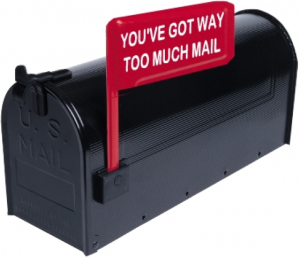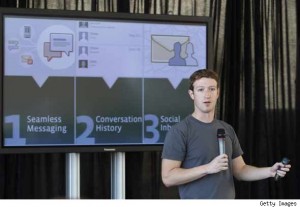 “The odd thing about this form of communication is that you’re more likely to talk about nothing than something. But I just want to say that all this nothing has meant more to me than so many somethings.” Kathleen Kelly aka shopgirl@aol.com (Meg Ryan) sent this e-mail to Joe Fox aka ny152@aol.com (Tom Hanks) in the Warner Bros 1998 movie “You’ve Got Mail”, named after the trademark greeting that AOL users hear when they receive new email. Katheleen’s e-mail was one of the 246 million emails sent every day by the 77 million email users in the US back in 1998. Since then, the use and adoption of email have grown exponentially both in the consumer as well the enterprise space. Without a doubt, email has become the cornerstone for communication and collaboration within and outside companies. According to “Email Statistics Report, 2009-2013” by The Radicati Group, last year there were 2,332 million of active email mailboxes worldwide, with 25% corporate mailboxes. This translates, thanks to the network effect, into 247 billion of emails sent everyday!
“The odd thing about this form of communication is that you’re more likely to talk about nothing than something. But I just want to say that all this nothing has meant more to me than so many somethings.” Kathleen Kelly aka shopgirl@aol.com (Meg Ryan) sent this e-mail to Joe Fox aka ny152@aol.com (Tom Hanks) in the Warner Bros 1998 movie “You’ve Got Mail”, named after the trademark greeting that AOL users hear when they receive new email. Katheleen’s e-mail was one of the 246 million emails sent every day by the 77 million email users in the US back in 1998. Since then, the use and adoption of email have grown exponentially both in the consumer as well the enterprise space. Without a doubt, email has become the cornerstone for communication and collaboration within and outside companies. According to “Email Statistics Report, 2009-2013” by The Radicati Group, last year there were 2,332 million of active email mailboxes worldwide, with 25% corporate mailboxes. This translates, thanks to the network effect, into 247 billion of emails sent everyday!
Notwithstanding, this gigantic volume of information poses a complex challenge in order to manage, select and process the useful messages from the 110 emails received/sent per day by an average corporate user. As a matter of fact, 81% of the total e-mail traffic is spam. In engineering language, the signal-to-noise ratio, which measures how much a signal has been corrupted by noise, is only 0.25. That is to say, a very poor ratio of useful information to irrelevant one. However, the latest improvements in spam filters have enabled a dramatic reduction of about only 20% of spam reaching user mailboxes. Nevertheless, reducing or even eliminating completely the spam does not solve the overload email problem. When we question about this issue to the participants of our executive education programs, a high percentage answer that at least 70% of received emails are useless and constitute a distraction from important tasks. This informal perception is corroborated in a new study from researchers at Stanford and Boston University, which indicates that e-mail overload can affect stress level and the performance at the workplace.
 For the time being, email is here to stay as an important intake of an average workday diet: 25% email-related tasks, 14% personal meetings, and 9% phone conversation, data from The Radicati Group report. Many software companies are trying to ease the pain of mailboxes introducing tools built on top email services. Last August, Gmail introduced Priority Inbox, which automatically identifies the important email and separates it out from the rest of the messages of your inbox. Along the same lines, AOL and Yahoo! recently launched new improved email services. Other companies are taking the approach of creating a visual user interface, to easily identify messages based on importance and/or urgency.
For the time being, email is here to stay as an important intake of an average workday diet: 25% email-related tasks, 14% personal meetings, and 9% phone conversation, data from The Radicati Group report. Many software companies are trying to ease the pain of mailboxes introducing tools built on top email services. Last August, Gmail introduced Priority Inbox, which automatically identifies the important email and separates it out from the rest of the messages of your inbox. Along the same lines, AOL and Yahoo! recently launched new improved email services. Other companies are taking the approach of creating a visual user interface, to easily identify messages based on importance and/or urgency.
However, the main question is whether email is anymore an effective tool to communicate and collaborate in the enterprise space. In that regard, there is a battle to define and deploy the next-generation collaboration/communication tool. Many of these initiatives are based on adding the social component like IBM’s Project Vulcan with a user interface in facebook format or Microsoft’s Outlook Social Connector integrating information from LinkedIn, Facebook and MySpace. Last year, a lot of hype was built by the media around the launch of Wave. This Google product was defined as a new Internet communications platform. However, Wave failed to communicate its utility with low user adoption, to the extent that Google decided last April discontinuing developing Wave as a standalone product.
 Mark Zuckeberg, Facebook CEO, stated “We don’t think a modern messaging system is going to be e-mail” during the announcement of the new Facebook Messages, last week. Along the same lines, Sheryl Sandberg, Facebook COO, said at Nielsen’s Consumer 360 conference that email is probably going away. She based that forecast on the fact that only 11% of US teens email each day. Instead, teenagers sent over 3,000 text messages a month, compared to the 400 text messages sent by people between 35 and 44 years old according to a Nielsen report. Sandberg believes that in the same way that we seldom post a handwriting letter, future corporate workers will not use e-mail as the preferred communication mechanism.
Mark Zuckeberg, Facebook CEO, stated “We don’t think a modern messaging system is going to be e-mail” during the announcement of the new Facebook Messages, last week. Along the same lines, Sheryl Sandberg, Facebook COO, said at Nielsen’s Consumer 360 conference that email is probably going away. She based that forecast on the fact that only 11% of US teens email each day. Instead, teenagers sent over 3,000 text messages a month, compared to the 400 text messages sent by people between 35 and 44 years old according to a Nielsen report. Sandberg believes that in the same way that we seldom post a handwriting letter, future corporate workers will not use e-mail as the preferred communication mechanism.
Following that reasoning, Facebook Messages, which is being gradually rolling out to the 500 million Facebook users, has been designed taking into account that e-mail is too formal especially for young people who have grown up using text messages and online chats. Facebook Messages introduces the concept of a Social Inbox, where messages are sorted out based on your social graph. It also combines the messages in unified conversations, regardless if they are e-mail, chat or text messages. In the short term, Facebook Messages does not seem to pose a threat to corporate email. However, if this new product succeeds, Gartner Research predicts that it will ultimately influence enterprise collaboration strategies, given the current consumerization trend.
It is too early to know if Facebook Messages will follow a similar fate than Wave. Nevertheless, given the high levels of “cholesterol” of our overload mailboxes, we should consider at least changing our communication/collaboration workday diet into a more productive one. Then, it will be time to make an updated version of “You’ve Got Mail.”



I don’t think email is going anywhere. While it may be true that youngsters send more text messages than email, I think they turn to email as they start maturing. Email itself is obviously evolving and offers new and improved ways to communicate.
Priority inbox does an outstanding job at identifying the important emails from the not so important ones.